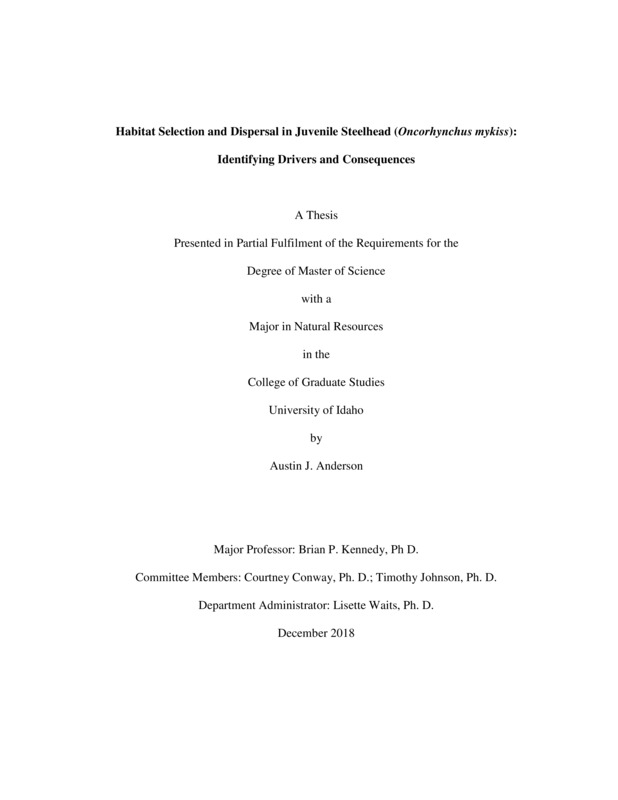Habitat Selection and Dispersal in Juvenile Steelhead (Oncorhynchus mykiss): Identifying Drivers and Consequences
Anderson, Austin John. (2018-12). Habitat Selection and Dispersal in Juvenile Steelhead (Oncorhynchus mykiss): Identifying Drivers and Consequences. Theses and Dissertations Collection, University of Idaho Library Digital Collections. https://www.lib.uidaho.edu/digital/etd/items/anderson_idaho_0089n_11484.html
- Title:
- Habitat Selection and Dispersal in Juvenile Steelhead (Oncorhynchus mykiss): Identifying Drivers and Consequences
- Author:
- Anderson, Austin John
- Date:
- 2018-12
- Embargo Remove Date:
- 2020-07-08
- Keywords:
- dispersal habitat selection juvenile salmonid steelhead
- Program:
- Natural Resources
- Subject Category:
- Natural resource management
- Abstract:
-
The need to study rivers as complex, continuous, and hierarchical ecosystems to obtain a more comprehensive understanding of ecological processes is becoming increasingly clear. For juvenile anadromous salmonids, this scientific endeavor is uniquely essential as their life history strategies are based upon movement through habitats ranging in scale from small streams to the Pacific Ocean. A major factor influencing their odds of successfully completing this life cycle is their performance during the juvenile freshwater stage, and this performance is heavily influenced by habitat opportunities. Habitat selection in freshwater is closely linked with dispersal behavior, which facilitates movement between habitats of variable quality. The objectives of this study were to evaluate juvenile steelhead (Oncorhynchus mykiss) habitat selection and dispersal on an intermediate spatial scale that bridged the microhabitat (individual), reach (<200m), and watershed levels. I accomplished my research objectives by following the fates of tagged fish in a spatially explicit fashion over hundreds of meters and through dozens of habitat units at multiple sites across a watershed. I demonstrate that dispersal is a strategy practiced by a minority of rearing steelhead that allows individuals to leave unfavorable habitat and seek out better opportunities in underutilized areas. I show that young of year and age 1+ steelhead select for different aspects of stream habitat and have different dispersal tendencies, and I illustrate how the growth consequences of habitat selection are heavily dependent on the spatial scale of investigation. Lastly, I recommend that juvenile steelhead age/size cohorts be considered separately when planning for management and conservation actions.
- Description:
- masters, M.S., Natural Resources -- University of Idaho - College of Graduate Studies, 2018-12
- Major Professor:
- Kennedy, Brian P
- Committee:
- Johnson, Timothy R; Conway, Courtney J
- Defense Date:
- 2018-12
- Identifier:
- Anderson_idaho_0089N_11484
- Type:
- Text
- Format Original:
- Format:
- application/pdf
- Rights:
- In Copyright - Educational Use Permitted. For more information, please contact University of Idaho Library Special Collections and Archives Department at libspec@uidaho.edu.
- Standardized Rights:
- http://rightsstatements.org/vocab/InC-EDU/1.0/

